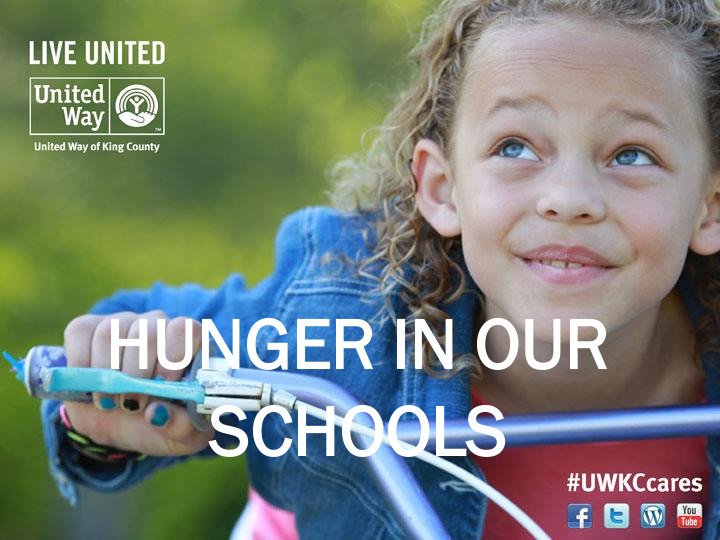



HUNGER GER IN OUR R SCHO HOOLS LS
Snapshot t of Child Hunge nger • 1 in 5 children in WA struggles with hunger • 76,000 estimated children are food insecure in King County (Map the Meal Gap, 2015)
Scho hool Meals - School Breakfast - School Lunch - Afterschool Meals - Summer Meals Many y childr ldren consu sume me half f of their calo lories s and a majority y of their meals ls at school. l.
Benefits of School Breakfast • 40% fewer missed school days by students who are eligible for free and reduced-price food • 17.7% fewer suspensions and expulsions on average • 3.75% more students meeting national reading standards on average (Washington Appleseed, 2014)
Scho hool Meals are Imp mportant! “There may be some households where that may be the only meal. They try to make things stretch and they may not get enough, and so it is good that there is breakfast available at school. Because there are households that can’t afford enough food to make it stretch.” - Renton Senior High Parent, Renton
School Meals Continued • These programs are: – Federally funded – Widely underutilized As a result, we we hav ave hungr gry students and we we are leavi ving g millions of federa ral dollars ars on the table
Imp mportanc nce of Scho hool Meals It is impossible for any child to learn when you are hungry. When you are real hungry, that’s the only thing that you can think about. You aren’t worried about math or reading or anything. “Feed me.” Because of that I believe in free meals for every child regardless of income. No child should be punished because they are poor.- Roxhill Elementary, SPS
Healthy, Hunger Free Kids Act of 2010 • Increased the nutritional standards for meals served at schools (more fruits, vegetables, whole grains, lean proteins, and reduced sugar, fat, and sodium) • Created the Community Eligibility Meal Provision
Implementation of HHFKA More kids are eating fruits and vegetables More kids are eating school breakfast 90% of schools are successfully implementing the standards (USDA Fact Sheet, 2014)
Community Eligibility • Meal provision that provides free breakfast and lunches to all students regardless if they are enrolled in the free and reduced lunch program • Reduces barriers to serving more students nutritious meals everyday!
Community Eligibility Provision CEP is based off of a school or school districts’ Identified Student Percentage (ISP); schools must have ISP >40% to participate ISP comes from directly certified students enrolled in Basic Food, TANF, or FDPIR OR students identified as homeless, migrant, or foster youth
King County CEP • The higher the ISP, the more feasible it is for a school district to participate and get a higher reimbursement rate • Chall llenge: Significant differences in ISP levels versus Free and Reduced Lunch (FRL) percentages although the income limits are less (185% for reduced and 135% for free)
Imp mportanc nce of Basic Fo Food Outreach Many barriers exist for families eligible for Basic Food in general, and targeting families through schools can make it especially challenging
Importance of Basic Food Outreach BUT… more families eligible and accessing Basic Food means that more schools and more students can access free meals through CEP Greater community food security and greater family food security
Supporting Families in the Gap “This is the first year that our income has allowed us to be a part of the free lunch program. And before, it was always a challenge. The resources being there for the lunch money. I got to put away $90, $120 a month. Wow, we are a little short! What are we going to do?” – Neely O’brien Elementary, Kent
Targe geted King ng County unty Distr tricts ts Federal Way School District Highline School District Kent School District Renton School District Seattle School District Tukwila School District
Where Does Your Outreach Fit In?
QUESTIO IONS NS?
Breakout Session Goals • What are the challenges you have found working with schools in your community? • What are the barriers you have found in working with families in your community? • How can the barriers in working with families be best overcome? • How could you be best supported and motivated to target eligible families?
Recommend
More recommend